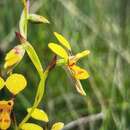pms
nòm ant ël fil


Diuris chrysantha, commonly known as granite donkey orchid,[2] is a species of orchid that is endemic to eastern Australia. It has one or two leaves and up to seven deep golden to orange-coloured flowers with brown markings and occurs on the ranges and tablelands north from Tamworth to the Darling Downs.
Diuris chrysantha is a tuberous, perennial herb with one or two linear leaves 120–360 mm (5–10 in) long, 4–8 mm (0.2–0.3 in) wide and folded lengthwise. Between two and seven deep golden to orange-coloured flowers with brown markings and 18–20 mm (0.7–0.8 in) wide are borne on a flowering stem 150–320 mm (6–10 in) tall. The dorsal sepal is erect, egg-shaped, 7–9 mm (0.3–0.4 in) long and 6–7 mm (0.2–0.3 in) wide. The lateral sepals are linear to spatula-shaped, 12–18 mm (0.5–0.7 in) long, 2–4 mm (0.08–0.2 in) wide and turned downwards. The petals are more or less circular in shape, 6–8 mm (0.2–0.3 in) long and wide on a brown stalk 4–7 mm (0.2–0.3 in) long and held ear-like above the rest of the flower. The labellum is 7–9 mm (0.3–0.4 in) long and has three lobes. The centre lobe is heart-shaped to wedge shaped, 5–7 mm (0.2–0.3 in) long and 4–6 mm (0.16–0.24 in) wide and the side lobes are egg-shaped, 2.5–4 mm (0.1–0.2 in) long and 2.5–3 mm (0.098–0.12 in) wide. There are two callus ridges 2–3 mm (0.08–0.1 in) long and spreading apart from each other near the mid-line of the labellum. Flowering occurs from August to November.[2] [3]
Diuris chrysantha was first formally described in 1987 by David Jones and Mark Clements from a specimen collected near Stanthorpe and the description was published in Proceedings of the Royal Society of Queensland.[4] The specific epithet (chrysantha) is derived from the Ancient Greek words chrysos meaning "gold"[5]: 203 and anthos meaning "flower".[5]: 94
The granite donkey orchid grows in grassy forest on the ranges and tablelands north from Tamworth to the Darling Downs.[2][3]
Diuris chrysantha, commonly known as granite donkey orchid, is a species of orchid that is endemic to eastern Australia. It has one or two leaves and up to seven deep golden to orange-coloured flowers with brown markings and occurs on the ranges and tablelands north from Tamworth to the Darling Downs.